Kinross House, Kinross-shire
The restoration of the wonderful Kinross House was very much informed by the spirit of its original owner, finds Clive Aslet.
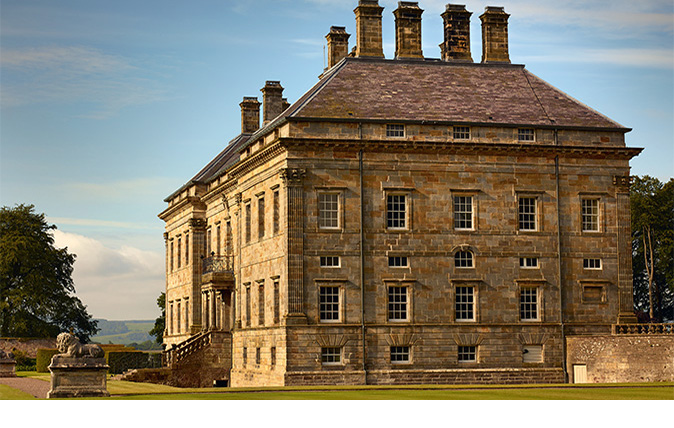
Country Life meets the brave man at the heart of the amazing restoration of Kinross House, Kinross-shire
Four years ago, Donald Fothergill came to Kinross House for the first time. He now likens his first sight of it to an out-of-body experience. The house seemed to reach out and grab him. ‘It had found me,’ he says, with conviction.
In part, that almost visceral response is a tribute to Sir William Bruce, the politician, grandee and architect who built Kinross for himself and brilliantly controlled his visitors’ approach to his house. Merely to find the gates provides a moment of drama: they lie at the end of a modest side street in the town of Kinross, 25 miles north of Edinburgh. They are handsome enough, having been built as part of a campaign to revive Kinross at the beginning of the 20th century, but, as they swing open, you see that a more enticing object in the distance, in the shape of a neat, unadorned mansion of the late 17th century, topped by a hipped roof and cupola (Fig 1, above).
As yet, it is far off—there is an avenue to go down before reaching it, ‘the noblest you could imagine,’ as Daniel Defoe described it in A Tour Through the Whole Island of Great Britain (1724–6). To appreciate Bruce’s orchestration of your arrival, it would be better to walk or ride down the avenue, or, preferably, be swept along it in a carriage.
But even by car, the visitor finds his sense of excitement and anticipation mounting, as he approaches the end of the trees; for here is a circle of grass (originally gravel), big enough for a cricket pitch, as can be seen from the wooden pavilion on the right. Care has to be taken in proceeding along the drive to avoid the oystercatcher who has made a nest on the gravel.
You can now see the house clearly. Unlike many Scottish houses, the natural austerity of which is enhanced by the use of grey limestone or granite, Kinross is built of sandstone, grey but strongly marked with streaks of orange. Screens that incorporate ogeeroofed pavilions—the house has no wings —sweep out to enfold the visitor; the curve is alternately concave and convex. Kinross is, in some ways, a restrained house, remarkable for its early use of sash windows, although these are set in large areas of wall.
The roof has no dormers, as it would do in an English house of this date. Clearly, Bruce had thought carefully about the way to simplify the design as far as possible, as the attic windows are inserted, quirkily, in a line between cornice and eaves. But, on approaching the front door, you find that the house is not without ornament: garlands of flowers are quarried out of the wall surface as if they are bubbling up from inside the stone.
Sign up for the Country Life Newsletter
Exquisite houses, the beauty of Nature, and how to get the most from your life, straight to your inbox.
The present owner, Mr Fothergill, had only come to look at the property on a whim, while being driven south from one of many frustrating and unsuccessful attempts to buy a shooting estate in the Highlands. He had, at that point, not thought of buying it, but events moved quickly. ‘Forty-five minutes before reaching the gates, I’d been asleep,’ he remembers. ‘An hour after arriving, I had shaken hands with the owners on the sale.’
The owner of engineering and IT businesses in Middlesborough, Mr Fothergill is a man who knows his own mind. He does not do things by halves, nor does he do them slowly. Since his purchase of Kinross, he has, effectively, taken the house to pieces and reassembled it, using a team of craftsmen from Scottish firms. It now has a sound roof, solid floor joists and efficient services, which can be run from a tablet anywhere in the world. Vaulted basement rooms that had previously been used to store an accumulation of family possessions have been turned into living spaces.
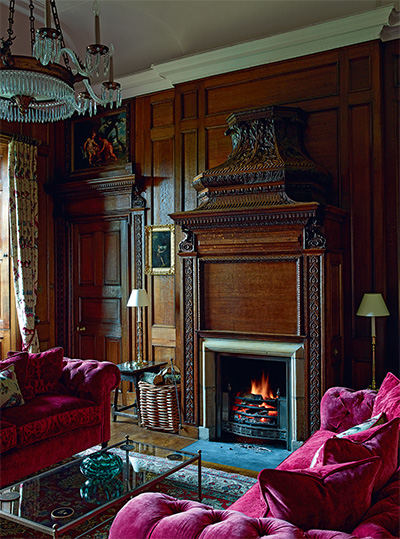
As thorough as it is possible to imagine, the restoration was completed in the almost unbelievably short time of 15 months. The architecture of the place has been scrupulously respected (Fig 4). Of course, it has been. Mr Fothergill feels the weight of destiny on his shoulder—and perhaps the hand of Bruce, whose portrait from 1664 hangs on the staircase hall. It shows a man of refinement, with a drawing implement in his right hand, presumably about to add a few strokes to the paper that he holds in his left.
His was a remarkable career (Country Life, October 14, 2009). This debonair individual played a key role in the Restoration of Charles II. As chaos descended after Cromwell’s death in 1658, he appears to have persuaded Gen Monck to support the return of the Stuarts and then to have acted as intermediary with the exiled Court. With the Restoration, Bruce’s star soared.
The second son of a Perthshire laird, his early years had been so unremarkable that almost nothing is known about them, but, under Charles II, he became a baronet, a Privy Councillor of Scotland, a collector of fines and taxes and the surveyor of the King’s works in Scotland. By 1665, he could buy the Balcaskie estate; the Kinross estate was bought from the nearly bankrupt Earl of Morton 10 years later. He soon began to lay out the garden.
The progress of the house he started in 1685 can be followed through a detailed set of accounts, recorded in Hubert Fenwick’s Architect Royal (1970). By this time, Bruce may have felt that a peerage was overdue, but his star crashed to earth as quickly as it had risen. Owing everything to the Stuarts, he became persona non grata after the abdication of James II. Kinross was never fully completed.
His son John struggled to maintain the house and gardens at Kinross and they quarrelled; the relationship was not improved when Bruce, a widower, remarried. If a memorial was raised after Bruce’s death in 1710, nothing is known about it. Kinross House could, however, be said to be Bruce’s monument. It must have astounded contemporaries. Nothing so selfassured, controlled by a giant Corinthian order, but magnificently restrained in its economy of detail, had been built in Scotland, or indeed England, before (Country Life, March 25 and April 1, 1965).
It could hardly have been predicted from Bruce’s own earlier works. Kinross shows a far more sophisticated understanding of Classicism than his quadrangle at Holyroodhouse, built a few years earlier. Thirlestane, which he remodelled for the effective ruler of Scotland, the Duke of Lauderdale, suggests a romantic eye for castle architecture. In this, Bruce anticipated Vanbrugh. And, although the origins of the Picturesque Movement are conventionally ascribed to Vanbrugh’s letter of 1709 to the Duchess of Marlborough about the restoration of the ruined Woodstock Manor, as an incident to stir reflection in a landscape, Bruce had already made a ruin —Loch Leven Castle—a key element of his conception at Kinross 30 years earlier. Loch Leven Castle, on an island in the middle of Loch Leven, was a Stuart icon. Mary, Queen of Scots had been brutally imprisoned there, until—in one of those glittering, romantic episodes that happened so often in the lives of the Stuarts—she charmed one of her gaolers into allowing her to escape.
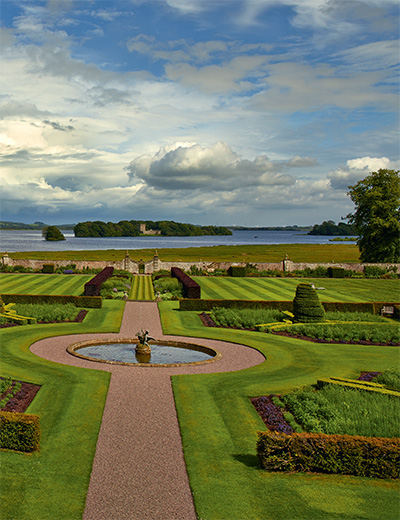
An axis runs from the entrance gates at Kinross, through the centre of the house and out through the garden gate, aligned on the castle (Fig 5). Bruce contrived that his house should lie at the exact midpoint between gates and castle. Bruce not only appropriated Loch Leven Castle as part of his view, but also, perhaps, hoped that its legend would become part of his own family story. Another strand of mental activity is indicated by the many sundials in the gardens: Bruce was evidently fascinated by the contemporary preoccupation with dialling, associated with the great question of a method of calculating longitude.
We can now appreciate Bruce’s idea for the setting, as well as the architecture of the house, as the garden has been reinstated according to the 17th-century plan, but using modern plants. Bruce’s family kept the house until 1777, when it was bought by an East India Company trader called George Graham. He left the estate to his illegitimate son, James, on condition that he marry his cousin, the daughter of George’s brother, Thomas Graham, who, failing this marriage, succeeded to Kinross.
As his own son had been killed by pirates, Thomas made it a condition of his will that Kinross would be inherited by whichever of his daughters produced a son first. It went to the youngest, Helen, and her husband Sir James Montgomery. At that time, however, the Montgomerys lived at Stobo, now a spa hotel, and so, from 1819, Kinross House was shut up. The Victorians, therefore, made no alterations. By the time Kinross came out of mothballs in 1902, architects such as Lorimer appreciated the Scottish tradition.
In his restoration, Sir Basil Montgomery employed the scholarly Dr Thomas Ross. By 2011, another century had passed and it was time for another campaign of work, into which Mr Fothergill threw himself with gusto. Happily, he was able to buy several key pieces of furniture from Mr and Mrs James Montgomery, who had previously lived here. From them came not only the portrait of Bruce, but also many pieces of 18th-century and Regency furniture, each of which has been given new life by Scottish restorers.
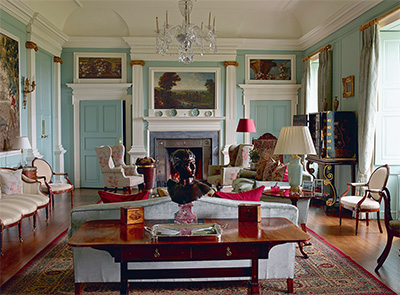
From the same source come family pictures to complement the overdoors and overmantels, presumably collected by Bruce while travelling (Fig 3). The new look is immediately apparent from the entrance hall, where the walls have been painted with light yellow, picked out with a subtly darker shade, with the screens of coupled Corinthian columns in white.
The floor, dark with the boots of ages, has been cleaned to reveal the same stone as the exterior of the house, its pronounced veining laid so as to suggest patterns (Fig 2).
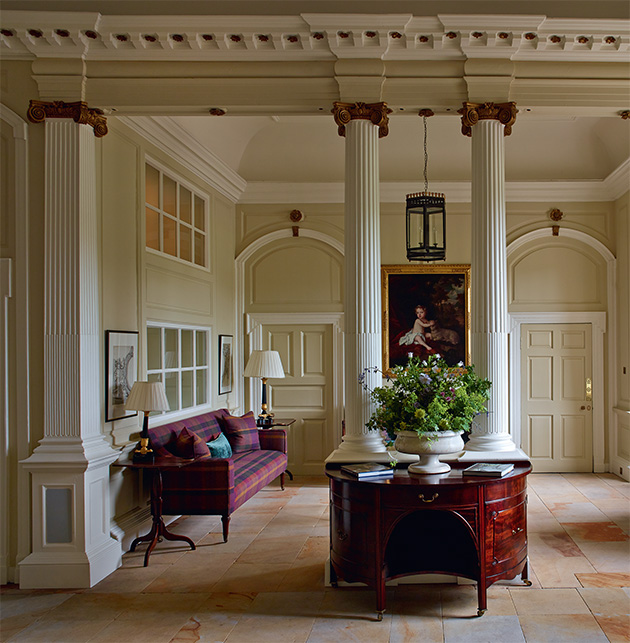
The dining room, previously in use as a kitchen, has been returned to its original purpose, with a ceiling celebrating the different owners of the house painted by Graham Rust (Fig 6).
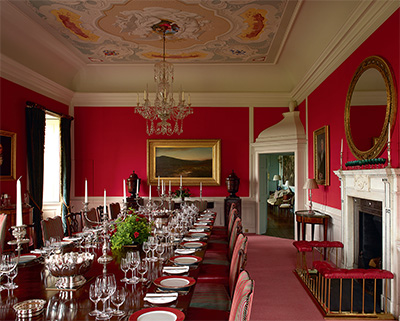
An even more striking achievement awaits visitors who ascend the oak staircase: the saloon on the piano nobile has not merely been redecorated by Mr Fothergill, but finished by him. Bruce’s work stopped in the Saloon, where the doorcases and fireplaces were left incomplete. Mr Fothergill succeeded in convincing Historic Scotland that he should add them —which pedants might regard as a controversial alteration to a Grade A-listed building. The triumph is now there to see (Fig 7).
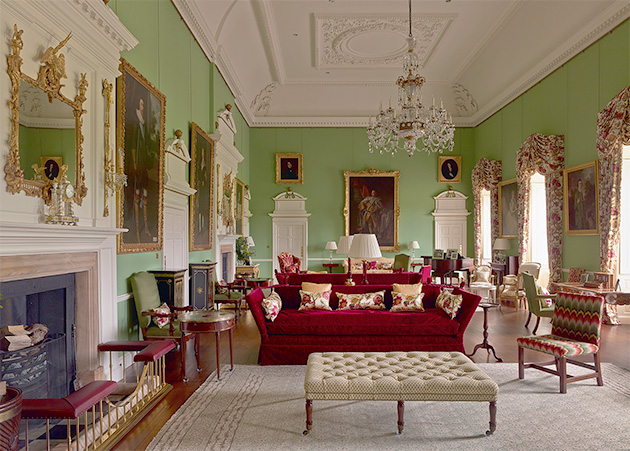
The room has, for the first time, acquired the proportions that Bruce intended for it. (Or almost: the coved ceiling is an insertion of 1902. The original form of Bruce’s ceiling is unknown, but it was higher.)
Having answered the call of Kinross House, Mr Fothergill could not complete his task until he had found a use for it, enabling the building to be a commercial success and thereby ensuring its long-term future. This he did by making it available throughout the year, fully staffed as a luxury exclusive-use property (www.kinrosshouse.com). Mr Fothergill continues to live in Yorkshire, visiting the property every few weeks. People who ask whether he intends to rescue other country houses observe a palpable twinkle in his eye. He is, perhaps, just awaiting the right property to call to him.
-
 The King's favourite tea, conclave and spring flowers: Country Life Quiz of the Day, April 22, 2025
The King's favourite tea, conclave and spring flowers: Country Life Quiz of the Day, April 22, 2025Tuesday's Quiz of the Day blows smoke, tells the time and more.
By Toby Keel
-
 London is the place for me* (*the discerning property buyer)
London is the place for me* (*the discerning property buyer)With more buyers looking at London than anywhere else, is the 'race for space' finally over?
By Annabel Dixon